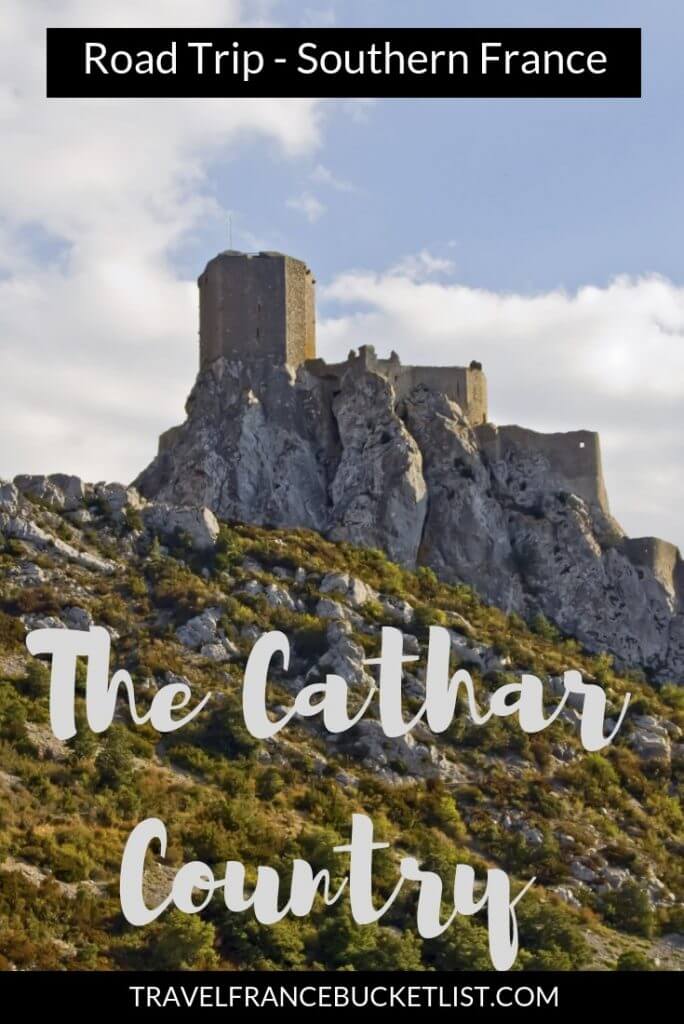Article written by Elisa - Travel Writer & Local in France
This article may contain compensated links. Please read disclaimer for more info.
Exploring the Cathar Region, France
The Cathar Region, France, is one of the most fascinating areas to visit, with an incredible heritage and a turbulent history of both heresy and crusades.
The Cathar Country (Pays Cathare in French) is much more than a Cathar Castles route. It is an ensemble of medieval castles, villages, and Romanesque abbeys related to the Cathars, France’s main heresy in the Medieval Times. These Cathar sites bear witness to the conflict between those who followed Catharism and the Catholic Church some 800 years ago.
The best way to explore the Cathar Country is by car, as most of these Cathar castles and other sites are poorly served (or not served at all) by public transportation. This 5-day Cathar Country road trip, with a start and finish in Carcassonne, is one of the best road trips in France. It covers the departments of Ariège and Aude in the region of Occitanie, and it is an excellent opportunity to learn about this fascinating chapter in France’s history.
The Cathar Country, France, is located in the Occitanie region (Southern France) and extends from the Mediterranean coast to the Montagne Noire, mainly in the department of Aude, but also in Ariège and Tarn.
Cathar Country Road Trip Overview
- Start: Carcassonne
- Finish: Carcassonne
- Duration: 5 to 6 days
- Suggested Route: Carcassonne – Cucugnan – Fontjoncouse – Carcassonne
- Total distance: 416.2 km, 7hrs 9min drive in total
- Regions covered: Occitaine
- Best for: history, sightseeing, landscapes, and small towns.
The first stop on your Cathar Country road trip is Carcassonne, one of the must-visit Cathar sites. You can travel to Carcassonne from various cities in the south and from a good part of the major French cities. Direct TGV trains connect Carcassonne to Dijon, Lyon, Marseille, Toulouse, or Bordeaux.
There are around 18 daily trains from Paris to Carcassonne, and it usually takes about 6 hrs 34 min, with a change along the way.
Click here to buy your train tickets to Carcassonne
For this Cathar Country itinerary from Carcassonne, you don’t need the car until day 2, so if you are taking a self-drive vacation to the Cathar region in a hire car, wait until then to pick up your rental car in Carcassonne – Click here to rent a car in Carcassonne
If this is your first trip to France, check out our tips for renting a car in France.

Road Trip Cathar Country Map
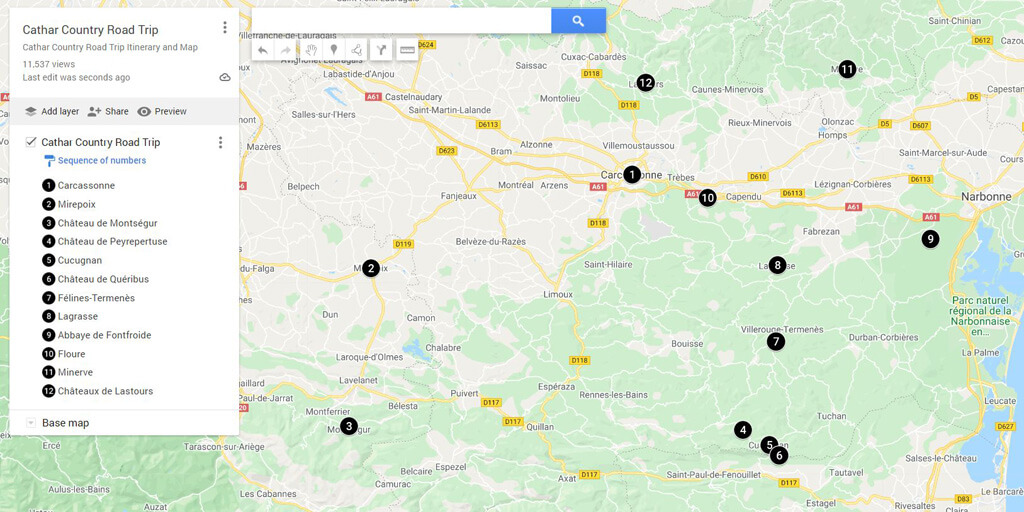
Click here to view this road trip Cathar Country Map on Google
About the Cathars in France and the Catharism
Who were the Cathars? The Cathars were the followers of Catharism, a Christian movement that thrived in southern Europe, especially in the historical region of Languedoc, between the 12th and 14th centuries.
The Cathar religion proposed a different interpretation of the Gospels, rejecting, in particular, all the sacraments of the Catholic Church (baptism of water, Eucharist, marriage, etc.) and the excesses enjoyed by its priests and bishops. Catharism was viewed as heresy by the Catholic Church, which was the predominant religion in France.
Catharism had incredible success in Languedoc, a region with a brilliant and refined civilization, much different from France north of the Loire. In the Cathar region, troubadours, poets, and musicians sang of love, honor, and using skills to succeed, quite different from the practice of the time, which was that the richest, strongest, and most noble families prevailed. The Cathar religion was, however, supported and protected by many influential people in the region, such as the Counts of Toulouse.
The Cathar Crusades (1209 -1226)
From the beginning of his mandate, Pope Innocent III attempted to end Catharism by sending missionaries to the Cathar region and persuading the local authorities to act against them.
In 1208, the papal legate Pierre de Castelnau was murdered on the way back to Rome after excommunicating Count Raymond VI of Toulouse, who, in his view, was too tolerant of the Cathar heresy. Pope Innocent III declared the Cathars heretics and launched the Albigensian Crusade to exterminate Catharism.
There were two Crusades against the Cathars in France, and it was only at the end of the second Cathar Crusade in 1226 when the few surviving Cathars capitulated, and Catharism was stamped out.
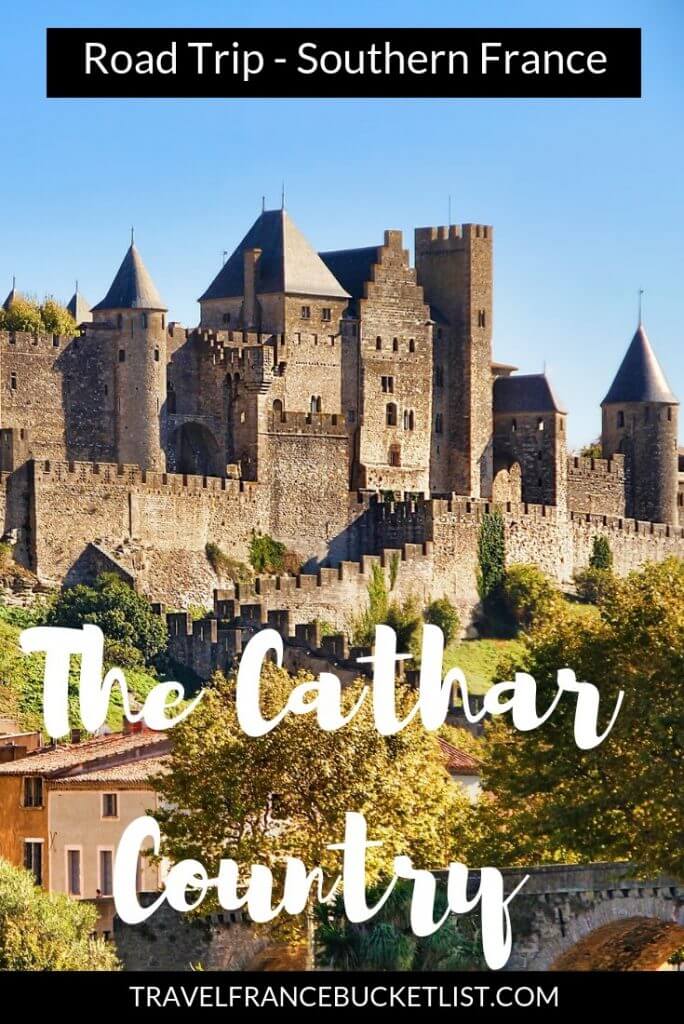
Road Trip Cathar Country – Itinerary 5 Days
Day 0 | Arrival in Carcassonne
As this road trip begins in Carcassonne, take this opportunity to explore this wonderful city before hitting the road. There is no road trip travel on the first day of this Cathar Country driving holiday, but we have included recommendations on what to visit and where to stay.
For your stay in Carcassonne, book two nights at the hotel Mercure Carcassonne La Cité. This charming hotel comes with free private parking, and it has beautiful air-conditioned rooms and a garden, plus a swimming pool with fantastic views over the walled city.
Click here to book your stay at Hotel Mercure Carcassonne La Cité
Day 1 | Carcassonne Castle and Citadel
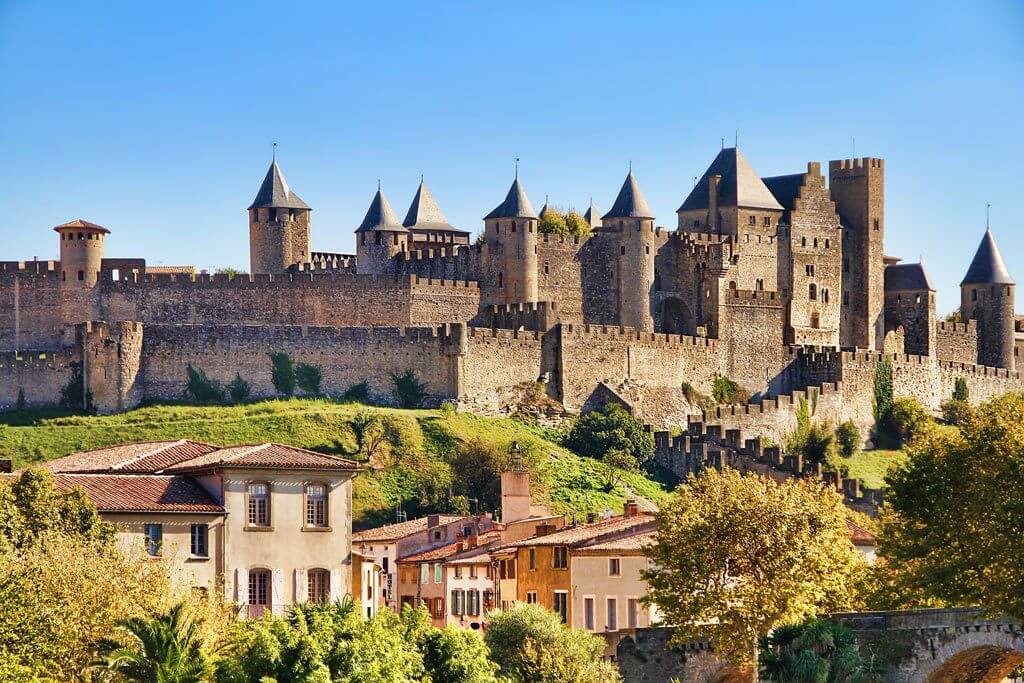
The Cité de Carcassonne is one of the most important sites to visit in the Cathar Country. The Cathar religion had many followers within Carcassonne’s walls. Raimond-Roger Trencavel, Viscount of Carcassonne, protected the Cathars, and soon the city became a land of heresy in the eyes of Pope Innocent III.
As a result, Carcassonne was one of the main targets during the first Cathar Crusade in 1209, which was led by Simon de Montfort. The two burgs around the Citadel fell quickly, and they were burned and destroyed while the fortress resisted the attacks well.
It was drought and thirst that made the Viscount of Carcassonne capitulate after two weeks of siege. On 14th August 1209, Raymond-Roger and nine of his subordinates were given safe conduct to discuss the terms with the besiegers, and they accepted the terms. But then, in breach of the safe conduct, Raymond-Roger was seized and immediately thrown into prison, where he died in mysterious circumstances.
Today Carcassonne Castle and the Citadel, with its winding alleys, are the city’s main Cathar sites, while the Lower City, built after the siege, is of a completely different design.
The visit to the Citadel and Carcassonne Castle is self-guided, and you can also walk along the walls. However, it is a good idea to take a guided tour with a knowledgeable guide to learn more about the Cathars and Carcassonne’s terrible past.
TIP: This 2-hour Cité de Carcassonne Guided Tour always gets great reviews!
Day 2 | Mirepoix and Montségur Castle
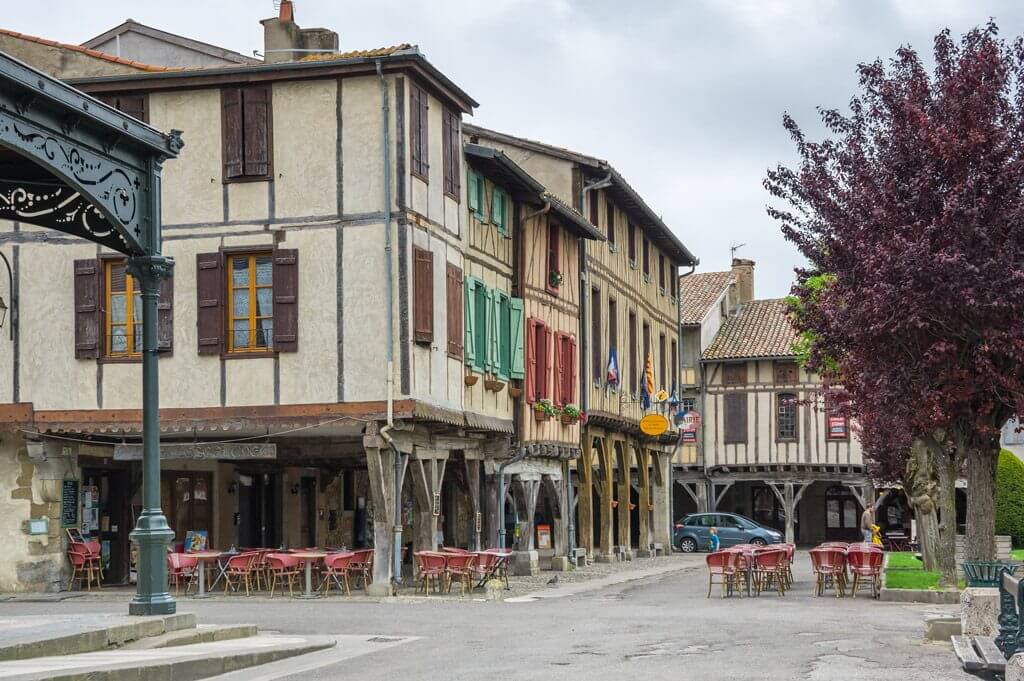
It’s time to hit the road to explore more Cathar sites. Day 2 of this Cathar Country road trip takes you to the medieval village of Mirepoix and the Cathar castle of Montségur.
Mirepoix was an important Cathar village in the region. From 1206, a great Cathar council gathered up to 600 Perfects (the highest authorities in the Cathar religion) in the village.
Originally, Mirepoix was located on the Hers-Vif River’s right bank, but it was destroyed by a violent flood in 1289. A new village was rebuilt on the other side of the river following a plan which was typical of the 13th century and known as bastida.
Mirepoix is one of the most beautiful villages in the Cathar region, France. Mirepoix has preserved a 14th-century fortified gate and a stunning market square surrounded by beautiful half-timbered houses from its medieval past. The café-terraces, shops, and the traditional market on Monday mornings make it a lovely spot to visit.
After Mirepoix, the road trip continues to Montségur to visit its castle. Montségur Castle is one of the most important castles on the Cathar Castles map because it was the last focus of Cathar’s resistance against the Crusaders.
Montségur Castle is perched on the top of a rocky spur at an altitude of 1,207 meters, and it overlooks the village with the same name. The castle was under siege four times, but the Crusaders would only take it in 1244.
The stronghold was besieged for ten months before being taken by the royal army in March 1244. After the surrender, all the Cathars who refused to deny their Cathar beliefs were burned at the stake. In all, two hundred people, all voluntary Cathars, died in the fire. It was reported that some sang during their sacrifice.
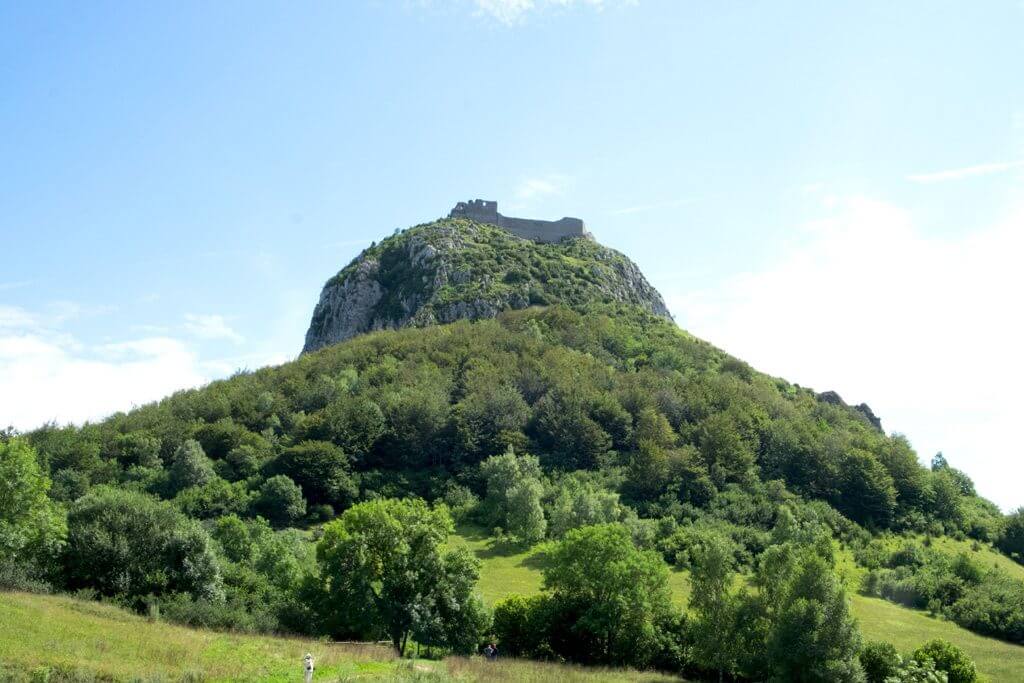
Before visiting Montségur Castle, we read that this is a place with a lot of energy. We could feel this energy even on the road leading to the Castle, especially when the Castle’s silhouette appeared to us on the horizon.
However, inside the fortress, everything was quiet and peaceful. In addition to its medieval remains, the Montségur Castle offers magnificent panoramic views over the village below and the surrounding scenery.
Day 2 ends in Cucugnan, a small village well situated for exploring the next Cathar villages and sites on this road trip. For the night in Cucugnan, book at the Logis Auberge du Vigneron. This is a former wine storehouse, and it offers guests comfortable rooms and a fabulous terrace overlooking the valley. The Auberge du Vigneron also has an on-site restaurant, perfect for your dinner in Cucugnan.
Click here to book your stay at the Logis Auberge du Vigneron
Day 3 | The Cathar Castles of Peyrepertuse and Quéribus
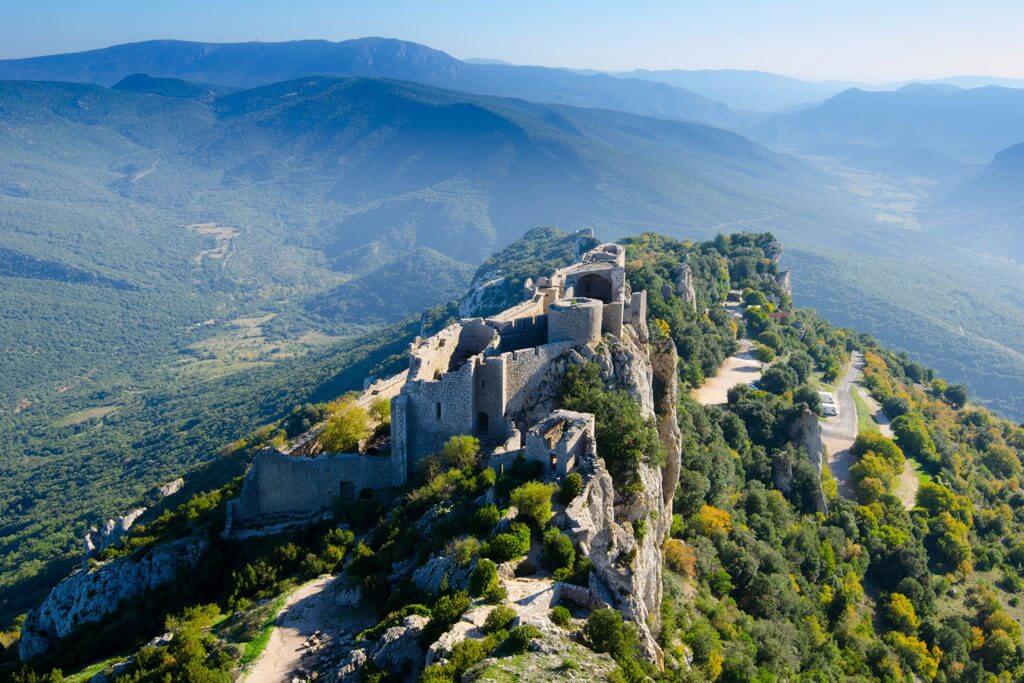
This day is dedicated to visiting the amazing Cathar castles of Peyrepertuse and Quéribus.
Château de Peyrepertuse is one of the most impressive Cathar castles in the Cathar Country, France, and one of the most beautiful castles in Southern France. This vertiginous citadel overlooking the Corbières Massif is sometimes called the “celestial Carcassonne.” From its position, it seems to touch the sky!
The lower part of the Cathar castle was built in the 11th century by the kings of Aragon in a strategic location. At the time of the Crusade against the Cathars, the castle was the fiefdom of Guillaume de Peyrepertuse, who, not wanting to submit, was excommunicated in 1224. Guillaume did finally submit after the failure of the siege of Carcassonne, and the castle became a possession of the French crown in 1240.
King Louis IX then built the higher part of the castle, the Sant Jordi Dungeon. An external staircase links both castles.
From the car park, it is a 20-minute walk up to the castle. On-site, visitors can still see evidence of military architecture from the Middle Ages and enjoy fabulous views.
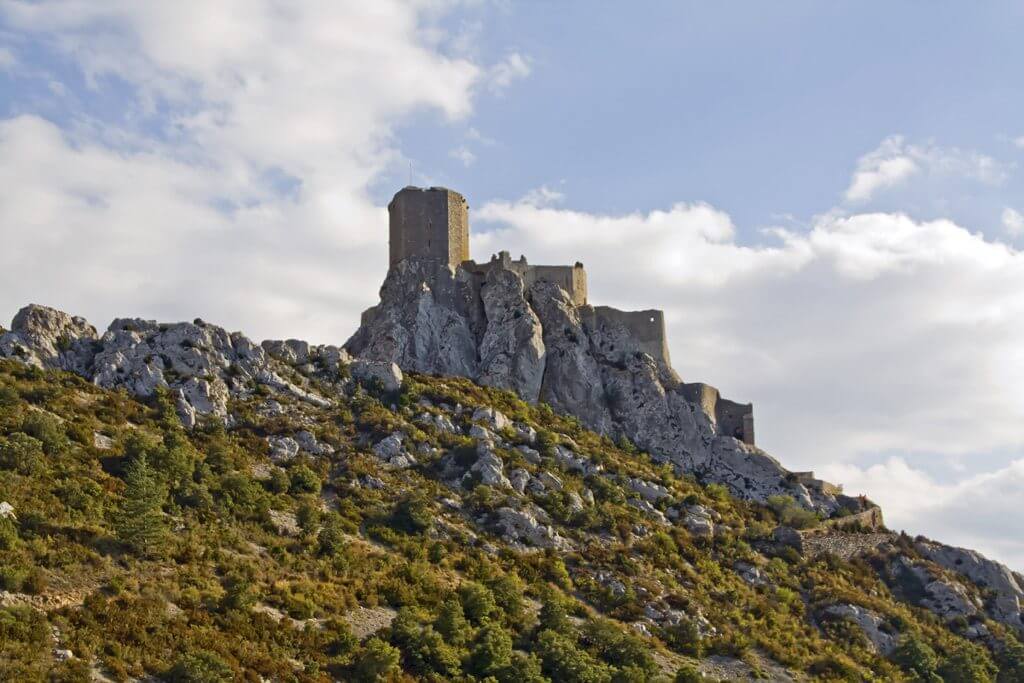
The Cathar Castle of Quéribus is another of the most impressive French castles on the Cathar Country map. It stands at the summit of a narrow, rocky peak in the heart of the Corbières Massif.
Quéribus Castle was another important Cathar refuge in the region, and it was the last stronghold of Cathar resistance to fall into the hands of the Crusaders in 1255.
Today the medieval fortress of Quéribus consists of a keep surrounded by three successive walls. It is a beautiful place to explore, with fabulous panoramic views over the Roussillon Plain, the Mediterranean, and the Pyrenées.
When you have completed your visit to the two castles, we recommend driving the 45km to Fontjoncouse. There are no Cathar sites here, but this gorgeous oh-so-typical French village in the heart of the Aude department is conveniently located close to the next Cathar sites.
Book a room (or a full cottage) for one night at Le Petit Clos, a charming guesthouse with a swimming pool, terrace, and garden. The breakfast is 100% homemade!
Book your stay at Le Petit Clos
For dinner, there’s a gastronomic restaurant located just 50 m from the property (Auberge du Vieux Puits).
Day 4 | Lagrasse and Fontfroide Abbey
From Fontjoncouse, drive 22 km to Lagrasse, near the Corbières Massif. Lagrasse is another picturesque village in the Cathar Country listed as one of the “Most Beautiful Villages in France.“
Wandering around Lagrasse is like taking a step back in time, with its medieval houses, a beautiful 14th-century covered market with stone pillars, and the old humpback bridge over the Orbieu River.
The Benedictine Abbey of St Mary of Orbieu, located in Lagrasse, was founded in the 8th century, and it had a considerable intellectual influence in the area. During the Cathar Crusades, the Abbey undertook the role of appeasement. Thanks to the monks of Lagrasse, the cities of Béziers and Carcassonne finally found peace with the King and the Church.
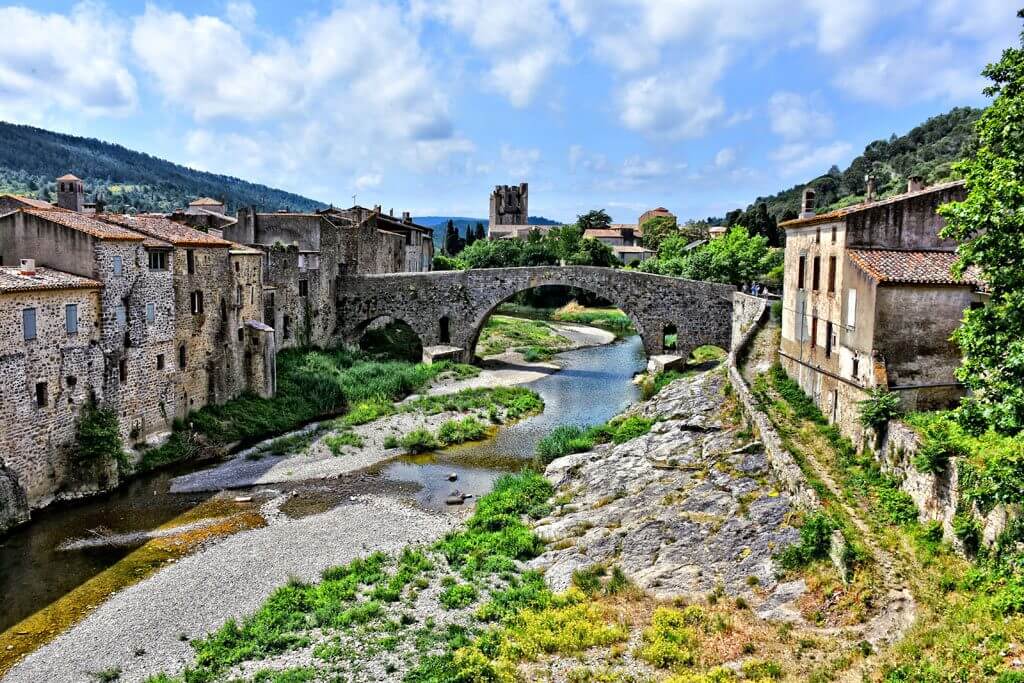
When you have completed your visit to Lagrasse, drive to Fontfroide Abbey, a beautiful Cistercian building. The Abbey was founded in the 11th century, and it played an important role in the campaigns against the Cathars.
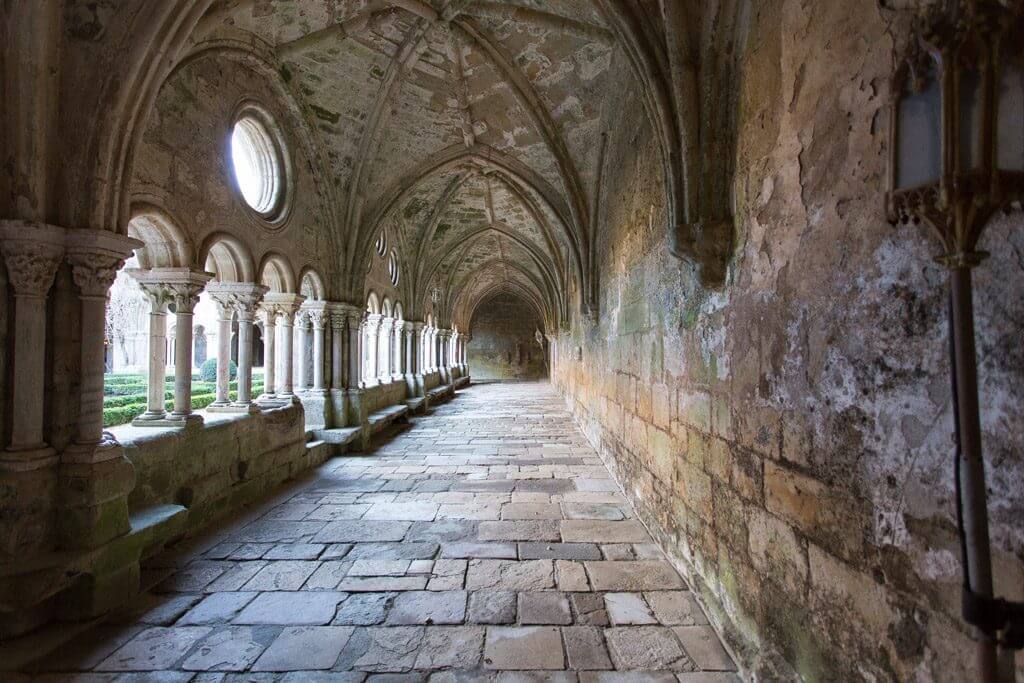
The monks of Fontfroide failed to convince the Cathars to abandon their beliefs by mere preaching. Pierre de Castelnau – the Pope’s legate charged with negotiating with the Cathars – was a monk of Fontfroide. His assassination in 1208 was the trigger that began the first Crusade against the Cathars.
Fontfroide Abbey was built following the typical Cistercian plan with a church, cloister, and a chapter house. Visitors can also see other constructions like the monks’ dorms, kitchens, and canteen. Later additions include side chapels around the church and a cour d’honneur (a three-sided ceremonial courtyard).
TIP: A visit to Fontfroide Abbey is always accompanied by a guide. Don’t hesitate to ask the knowledgeable guides all your questions about the Cathars in France!
The Abbey of Fontfroide has been cultivating vines for centuries. The plots are the work of the Cistercian monks. The Fontfroide terroir is conducive to the development of grapes with exceptional aromatic intensity, due in particular to the coolness of the Massif de Fontfroide climate, which causes the red and white grape varieties to ripen more slowly.
The Fontfroide Abbey vineyard is now classified HVE 3 and Terra Vitis and has been run by the same family since 1908, continuing the passion for wine developed by their predecessors. The winery offers tours & tastings in French, English, and Spanish, meals, or just commented tastings of 3 wines – Click here to see their offer
After visiting Fontfroide, we suggest that you drive to the village of Floure for the sole reason of spending the night at the fabulous Château de Floure & Spa. This is a historic place that began as a Roman Villa on the Via Aquitania, between Narbonne and Toulouse. During the Middle Ages, it became a monastery before writer Gaston Bonheur turned it into his home. Today, the property works as a château-hotel & spa, and it has stunning grounds, two swimming pools, and an on-site restaurant.
Day 5 | Minerve and Châteaux de Lastours
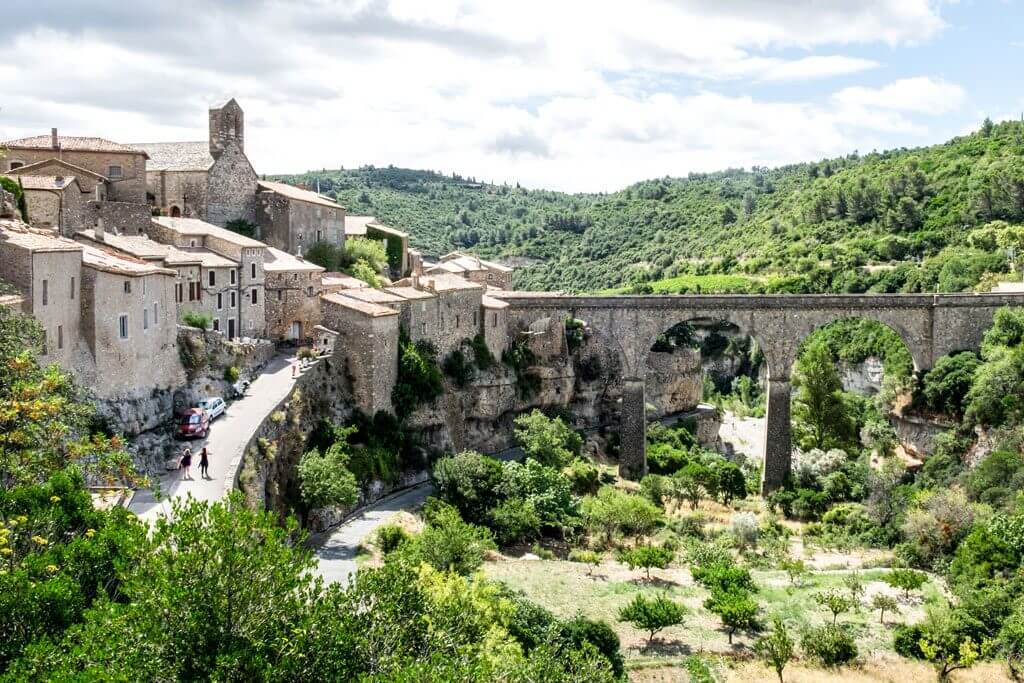
On day 5, there’s a big loop to visit two beautiful Cathar sites before heading back to Carcassonne, but it is well worth it!
Minerve is one of the cutest medieval villages in Southern France. Indeed, Minerve is another of the villages in the region listed as the “Most Beautiful Villages in France.”
The Cathar village of Minerve is best known for the siege it underwent in 1210 during the terrible Crusade against the Cathars. In Minerve, Simon de Montfort and the northern barons exploited the most advanced military technique of the time, the siege machine.
Four large catapults were built on-site, surrounding the walls of Minerve, and were used to throw stone balls and dead animals over the walls of the village to spread diseases. Today, visitors can see the reproduction of one of those catapults, named la Malvoisine, still threatening Minerve.
Minerve is a small medieval village that you can visit in one or two hours. Still, its beauty and good wines deserve a brief stop on the way to Lastours.
Châteaux de Lastours is one of the most beautiful castles in southern France. The site of Lastours is an exceptional ensemble of four Cathar castles (Cabaret, Surdespine, Quertinheux, and Tour Régine) built at the top of a rocky spur 300 meters above the village of Lastours, isolated by the deep valleys of Orbiel and Grésillou.
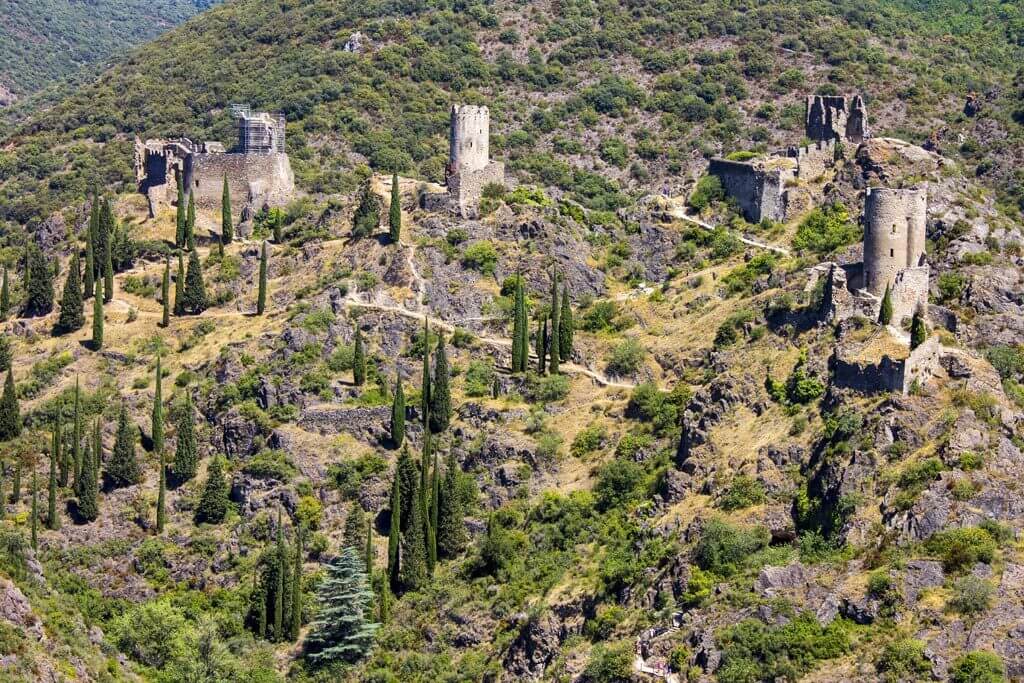
It appears that the lord of Cabaret, Pierre Roger de Cabaret, was very close to the Cathars. Between 1223 and 1229, Cathar’s activity in Cabaret was intense, and the castles were besieged by the Crusaders several times. Finally, in 1229 Cabaret surrendered, and the last Cathar parfaits escaped.
After the Cathar Crusade, the King of France took possession of the defeated lords’ property and territories, Cabaret included. The King destroyed the village and built the fourth tower, the Tour Régine, on top of the three primary structures.
Châteaux de Lastours is a fabulous place to visit, especially in spring or with the fall colors. From Belvedere Montfermier, you can admire the whole site with its beautiful castles.
From Lastours, it’s only a 17.1 km drive to Carcassonne, the end of this Cathar Country itinerary.
So, what are you waiting for? Book this fabulous road trip to the Cathar Country, France, today!
Pin it now & read it later
